
Description
The project’s primary goal is to optimize an existing 3D simulation software that monitors the operational status of a biomedical machine specializing in liquid handling. The focus is on improving the software’s performance and enhancing the functionality of the 3D viewer, creating a highly accurate real-time “digital twin” of the machine. Key improvements include integrating CAD-based mechanical components, enabling real-time synchronization with operational data, and ensuring seamless compatibility with the broader system architecture.
The project targets the following key outcomes:
- Software Optimization: Enhancing the efficiency and reliability of the 3D simulation software, originally developed in Go and powered by the g3n-engine graphics library.
- Mechanical Drawings Integration: Adding mechanical components from CAD models to provide a faithful, detailed representation of the machine.
- Real-Time Synchronization: Ensuring accurate real-time reflections of the machine’s operational status by processing live data streams.
- System Integration: Guaranteeing seamless compatibility between the optimized 3D viewer and the existing monitoring system through collaboration with the development team.
Why This System is Needed
Biomedical machines specializing in liquid handling demand precise monitoring systems to ensure operational accuracy and efficiency. The current 3D simulation software has several limitations that impact its effectiveness as a real-time monitoring tool:
- Insufficient 3D Rendering Capabilities: The current viewer lacks the detail necessary to accurately simulate the machine’s complex mechanical components, such as moving parts and fluid dynamics.
- Inadequate Real-Time Integration: The software struggles to synchronize with real-time data, preventing it from functioning effectively as a “digital twin.”
- Performance Bottlenecks: High-frequency data streams and large CAD-based models present processing challenges, leading to delays and reduced reliability.
- Scalability Issues: Without optimization, the system cannot accommodate future upgrades, such as integrating additional sensors or more detailed CAD models, without significant performance degradation.
- Integration Gaps: The lack of seamless communication between the 3D viewer and the broader system creates inefficiencies and increases manual intervention requirements.
These challenges highlight the need for a robust and scalable solution. By addressing these limitations, the project will deliver a high-performance 3D simulation tool capable of bridging the gap between physical machine operations and digital representation.
How We Plan to Achieve It
The project will be carried out through four key phases, focusing on enhancing the functionality, accuracy, and integration of the 3D simulation software:
1. Modification and Optimization of Existing Software
The project begins with improving the efficiency and reliability of the 3D viewer. This involves optimizing the software, developed in Go and powered by the g3n-engine graphics engine, to enhance its performance and stability. The optimization will target rendering capabilities, data handling, and overall responsiveness of the viewer to ensure seamless operation.
2. Integration of Mechanical Drawings
Mechanical components of the machine, obtained from CAD models, will be integrated into the 3D viewer. These parts will be incorporated into the simulation to accurately represent the structure and operation of the machine. This step aims to provide a highly detailed and faithful digital twin of the machine, capturing both its physical and functional characteristics
3. Real-Time Synchronization
Real-time synchronization capabilities will be implemented to ensure that the 3D viewer reflects the machine’s operational status with precision. By connecting the software to live data streams from the machine, the viewer will dynamically update to mirror real-world changes, delivering accurate and actionable insights in real time.
4. Collaboration with the Development Team
Close collaboration with other developers and engineers will be critical to the success of this project. This phase will ensure that the optimized 3D viewer integrates seamlessly with the broader system architecture. Regular communication and alignment with the team will be maintained to address technical challenges and ensure compatibility across all system components.
Project Timeline
- Analysis of Existing Software: 30–40 hours
- Software Optimization and CAD Integration: 60–80 hours
- Real-Time Data Synchronization: 50–70 hours
- Testing, Integration, and Documentation: 40–50 hours
Total Time Frame: 250–320 hours
